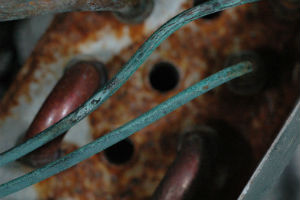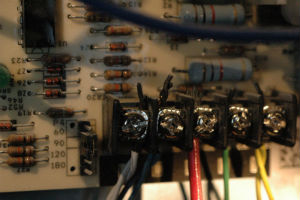It's a New Day in Public Health.
The Florida Department of Health works to protect, promote, and improve the health of all people in Florida through integrated state, county, and community efforts.
Case Definition
Questions about drywall?
Case Definition (12/18/2009) for Drywall Associated Corrosion in Residences
This revision of the 3/31/2009 Case Definition reflects our current understanding of this emerging problem and the results of recently released information regarding corrosive drywall testing. The sole purpose of this case definition is to help identify homes that are affected by corrosion associated with drywall emissions. The case definition is NOT intended to evaluate the health risks for occupants or to evaluate occupant exposures to corrosive emissions. This case definition is NOT regulatory in nature or required to be used by those inspecting homes. This case definition is provided to the public for informational purposes only and its use is strictly voluntary. Adoption of this case definition for purposes beyond its intended use is at the risk of the user. Criteria to demonstrate that a home is not affected by corrosive drywall emissions may require a different approach and inspection criteria that are not described in this document.
This version of the case definition enables the user to rank homes as a possible, probable or confirmed case. Homes that exhibit the sentinel indicators of drywall associated corrosion are defined as possible cases. All three sentinel indicators of Criteria 1 must be met for the home to be considered as a possible case. Criteria that define a probable or confirmed case are described in later sections.
Prior to embarking on efforts to remediate the home, one should perform sufficient evaluation to ensure the criteria for “confirmed case” are met and rule out confounding factors.
- ODORS AND SYMPTOMS
- CRITERIA 1: FOR HOMEOWNERS
- CRITERIA 2: FOR TRAINED PROFESSIONALS
- CRITERIA 3: FOR TRAINED PROFESSIONALS
- IMAGE GALLERY
Use of odors as an indicator of drywall associated corrosion is limited. Odors have not been reported in all homes exhibiting drywall associated corrosion.
Occupant reported health symptoms have limited use in identifying homes with drywall associated corrosion. The symptoms reported by occupants are not unique or consistent across affected homes.
Documenting the presence of odors and/or occupant symptoms may be important to public health agencies, but their relationship to the presence or absence of drywall associated corrosion in homes remains unclear.
Sentinel Indicators of Drywall Associated Corrosion (Possible Case = all 3)
- The home was constructed or renovated with new drywall since 2001.
- Observed corrosion of air conditioner evaporator coil exemplified by black corrosion on copper tubing components. The corrosion can result in refrigerant leakage making it impossible to cool the home requiring coil replacement. Coil failures indicative of this problem typically occur every 6-14 months
- Observed metal corrosion, indicated by blackening of one or more of the following:
copper wires, ground wires, and electrical connectors
un-insulated and un-coated copper pipes and fittings
chrome-plated bathroom fixtures
silver and copper jewelry
mirror backing in bathrooms
If you have answered yes to all three of the above indicators, the home meets the criteria for “possible case”. Continue to Criteria 2 or 3 only if home meets the criteria for “possible case”. Trained professionals performing home assessments based upon this case definition should use their experience, training, and professional judgment to establish their inspection procedures and sampling strategies. Professional judgment is necessary to determine the number of samples and weight of evidence needed to meet each set of criteria. A trained professional, not the homeowner, should conduct inspections and testing described in Criteria 2 and 3.
Supporting Indicators of Drywall Associated Corrosion (Probable Case = 1 or more)
- Observed markings on the back of drywall indicating the country of origin is China.
- Objective analysis of drywall in home finds Strontium levels exceed 2,000 mg/kg (ppm), indicating the gypsum used in the drywall was probably mined in China. Analytical methods commonly used for this include XRF and ICP. (2, 3, 5, & 7-12)
If you have met the criteria for “possible case” and answered yes to at least one of the above indicators in Criteria 2, the home meets the criteria for “probable case”. These criteria do not confirm that the drywall causes corrosion. Identifying the origin of the drywall is considered a screening tool for suspect drywall, but confirmation requires analysis described in Criteria 3.
Confirmatory Evidence of Drywall Associated Corrosion (Confirmed Case = 1 or more)
- Elemental sulfur (Orthorhombic sulfur, cyclooctasulfur, S8) content of gypsum core exceeding 10 mg/kg (ppm), indicating the gypsum in drywall samples from the home contains the source material that is believed to contribute to the reduced sulfur gasses emitted from corrosive drywall. Analytical methods commonly used for this include GC/ECD, GC/MS, or HPLC. (1-4, 6, & 8-11)
- Laboratory analysis of suspect drywall headspace for reduced sulfur gas emissions (H2S, COS, CS2) indicating drywall samples from the home emit reduced sulfur gasses capable of causing copper corrosion. Analytical methods commonly used for this include GC/SCD.6 Results that are indicative of corrosive drywall must be established by each laboratory based upon internal procedures, comparison to control samples, and validated methods.Qualitative analysis of suspect drywall for its ability to cause corrosion/blackening of copper under controlled conditions, indicating drywall samples from the home emit gasses capable of corroding copper. Results that are indicative of corrosive drywall must be established by each laboratory based upon internal procedures, comparison to control samples, and validated methods.
If you have met the criteria for “possible case”, ruled out other sources of hydrogen sulfide as significant contributors to copper corrosion in the home, and receive positive results on a sufficient number of samples from one or more of the above evaluations in Criteria 3, the home meets the criteria for a “confirmed case”. Some confounding factors that should be excluded as causes of observed corrosion are hydrogen sulfide from well water, sewer gas, or soil gas.

Blackening corrosion on copper tube of the evaporator coil inside the air handling unit. Some corrosion has been removed showing un-corroded metal.

Evaporator coil showing blue/green and dark red patina on copper tubing and dark orange rust on other metals.

Evaporator coils showing blue/green and dark red patina on copper tubing and dark orange rust on other metals.

Evaporator coils showing blue/green and dark red patina on copper tubing and dark orange rust on other metals.

Blackening corrosion on the exposed copper of wiring on the electrical panel inside an air handling unit.

Photo illustrates that homes were found with both domestic and Chinese manufactured drywall marked "MADE IN CHINA ASTM C36/C1396 STANDARD".
<
>
This page contains materials in the Portable Document Format (PDF). The free Adobe Reader may be required to view these files.


















































Connect with DOH